As Moodle encourages interaction and exploration, your students' learning experience will often be non-linear. Conversely, Moodle has few features for enforcing a specific order upon a course. For example, there is no feature in Moodle that would require a student to complete Course 101 before allowing the student to enroll in Course 102. Instead, you would need to manually enroll the student in each course. Also, there is no Moodle feature that would require a student to complete Topic 1 in a course before allowing the student to see Topic 2. If you wanted to enforce that kind of linear course flow, you would need to manually place the student into the group that is authorized to view Topic 1, and then upon completion, place the student into the group that is authorized to view Topics 1 and 2, and so on.
As a site administrator or teacher, enforcing a linear path through a course catalog, or through the material in an individual course, often requires manual intervention. However, if you design your site with Moodle's non-linear style in mind, you will find that it offers you great flexibility and the ability to create engaging online courses.
As Moodle becomes more popular, there is more demand for features that enforce a linear flow through a course. Modules are being developed to lock and open activities based upon a student's performance in previous activities. Check the Moodle.org news, roadmap, and modules pages for the status of these efforts.
In this section, I'll take you on a tour of a Moodle learning site. You will see the student's experience from the time the student arrives at the site, enters a course, and works through some material in the course. You will also see some student-to-student interaction, and some functions used by the teacher to manage the course. Along the way, I'll point out many features that you will learn to implement in this book, and how the demo site is using those features.
The Front Page of your site is the first thing most visitors will see. This section takes you on a tour of the Front Page of my demonstration site. Probably the best Moodle demo site on the Web is http://demo.moodle.org.
When a potential student arrives at the demonstration learning site, the student sees the Front Page. Later in this book, you'll learn to control what an anonymous visitor to your learning site sees on the Front Page. You can require the visitor to register and log in before seeing any part of your site, or allow the visitor to enter with a Guest account. Like most sites, my demonstration site allows anonymous visitors to see a lot of information about the site on the Front Page:
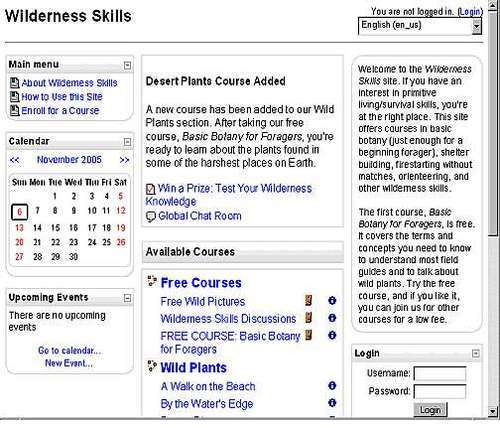
One of the first things a visitor will notice is the announcement at the top and center of the page, Desert Plants Course Added. Below the announcement are two activities: a quiz, Win a Prize: Test Your Wilderness Knowledge, and a chat room, Global Chat Room. Selecting either of these activities will require the student to register with the site.
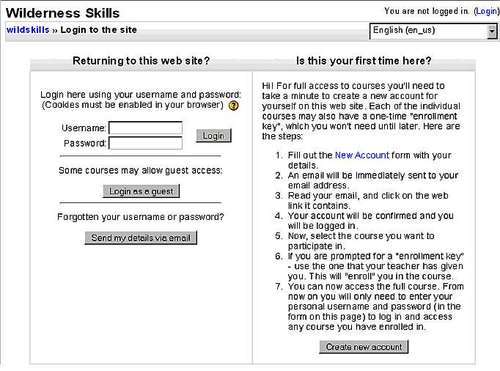
Note the line Some courses may allow guest access in the middle of the page. You can set three levels of access for your entire site, and for individual courses:
Anonymous access allows anyone to see the contents of your site's Front Page. Note that there is no Anonymous access for courses. Even if a course is open to Guests, the visitor must either manually log in the user as Guest or the site must automatically log in a visitor as Guest.
Guest access requires the user to login as Guest. This enables you to track usage, by looking at the statistics for the user Guest. But as everyone is logged in as the user Guest, you can't track individual users.
Registered access requires the user to register on your site. You can allow people to register with or without email confirmation, require a special code for enrolment, manually create their accounts, import accounts from another system, or use an outside system (like and LDAP server) for your accounts. There's more on this in Chapter 2.
Returning to the Front Page, notice the Main menu in the upper left corner. This menu consists of three documents that tell the user what the site is about, and how to use it.
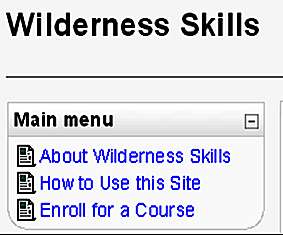
In Moodle, icons tell the user the kind of resources that will be accessed by a link. In this case, the icon tells the user these are web or text pages. The course materials that a student observes or reads, such as web or text pages, hyperlinks, and multimedia files are called Resources. In Chapter 4, you will learn how to add Resources to a course.
There is a Calendar and the Upcoming Events below the Main menu . These are blocks, which you can choose to add to the Front Page, and to each course individually.
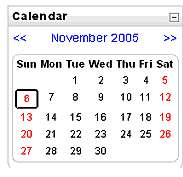
Other blocks display a summary of the current course, a list of courses available on the site, the latest news, who is online, and other information. In the lower right of the Front Page you can see the Login block. Chapter 3 tells you how to use these blocks.
You can add these blocks to the Front Page of your site because the Front Page is essentially a course. Anything that you can add to a course—such as resources and blocks—can be added to the Front Page.
On the right side of the Front Page you see a Site Description. This is optional. If this were a course, you could choose to display the Course Description.
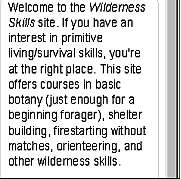
The Site or Course Description can contain anything that you can put on a web page. It is essentially a block of HTML code that is put onto the Front Page.
You can choose to display available courses on the Front Page of your site. In the Demonstration site, I've created a category for Free Courses and another for Wild Plants. Free Courses allow Guest users to enter. Courses in other categories require users to register.
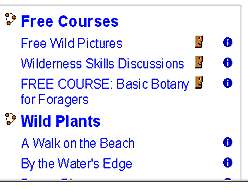
Clicking on the information icon _ch4.jpg) next to each course displays the Course Description. Clicking on a course name takes you into the course. If the course allows anonymous access, you are taken directly into the course. If the course allows Guest access, or requires registration, you are taken to the Login screen.
next to each course displays the Course Description. Clicking on a course name takes you into the course. If the course allows anonymous access, you are taken directly into the course. If the course allows Guest access, or requires registration, you are taken to the Login screen.
Now let us take a look inside the course.
In the next screenshot, the user has logged in as Guest and entered the Basic Botany course. We know this from the breadcrumbs trail at the top left of the screen, which tells us the name of the site and of the course. In the upper right, we see a confirmation that the user has logged in under the name Guest.
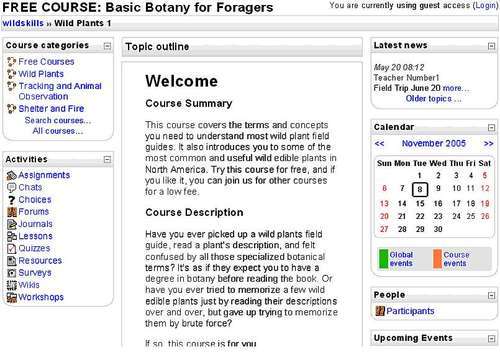
Similar to the Front Page, this course displays the Calendar and Upcoming Events blocks. It also displays blocks for the Latest news, People, Activities, and Course categories. The Activities block lists all of the types of Activities and Resources that are available in this course. Clicking on a link will display that type of activity. For example, clicking Quizzes displays this screen:

Note that the breadcrumbs at the top now indicate the site name, course name, and also indicate that you are viewing the quizzes in the course. The course is organized by Topic, and the number of each Topic is displayed in the left column. As the user is logged in as Guest, and many users can use that ID, the Best grade column is not meaningful here. It indicates only the highest grade for everyone who has ever attempted this quiz with Guest access. Clicking on the name of a quiz takes the user to that quiz. In the breadcrumbs at the top of the page (the navigation line), clicking on Wild Plants 1, takes the user back to the course.
Earlier, I commented on the non-linear nature of many Moodle courses. Note that even though the user has not completed Topic 1, the quizzes for Topic 2 and 3 are open to the user. Also, looking at the Activities block, you can see that all the resources for this course are available to the user at all times. Later, we'll discuss features that enable you to selectively hide and show different activities.
Moodle also enables you to organize a course by week, In that case, each section is labeled with a date, instead of a number. Or, you can choose to make your course a single, large discussion forum.
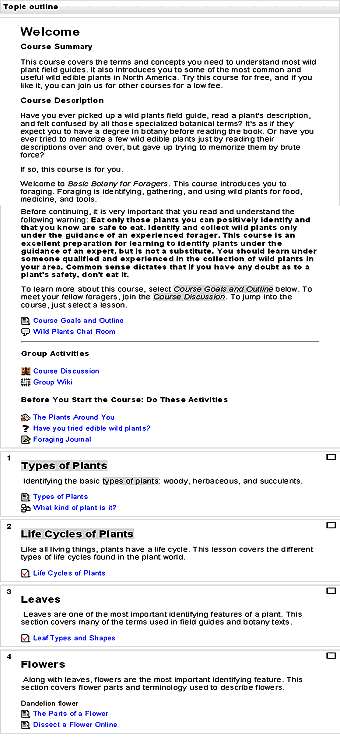
Most courses are organized by Topic. Note that the first topic, which I've labeled Welcome, is not numbered. Moodle gives you a Topic 0 to use as the course introduction.
Teachers can hide and show topics at will. This enables a teacher to open and close activities as the course progresses.
Topics are the lowest level of organization in Moodle. The hierarchy is: Site | Course Category | Course Subcategory (optional) | Course | Topic. Every item in your course belongs to a topic, even if your course consists only of Topic 0.
Clicking on Course Discussion, under Group Activities, takes the student to the course-wide forum. Clicking on the topic line opens that thread. You can see in this screenshot that the teacher started with the first post. Then William Rice left a test message, and a student replied to the original post:
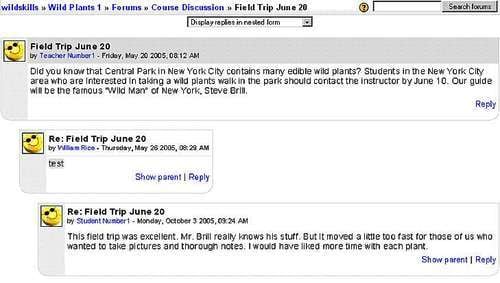
That test message doesn't serve our students. Fortunately, the teacher has editing rights to this forum. So he or she can delete posts at will. The teacher can also rate posts for their relevance, as shown in the following screenshot:
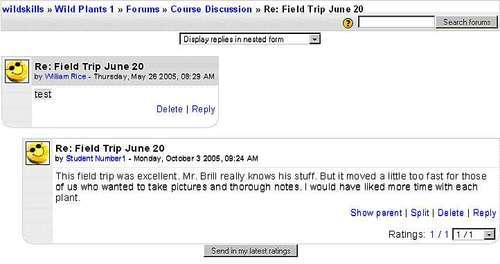
As Moodle supports an interactive and collaborative style of learning, students can also be given the ability to rate forum posts and materials submitted by other students. You'll find out more about forums in Chapter 6.
Next, the student will enter a workshop called Observing the Familiar.
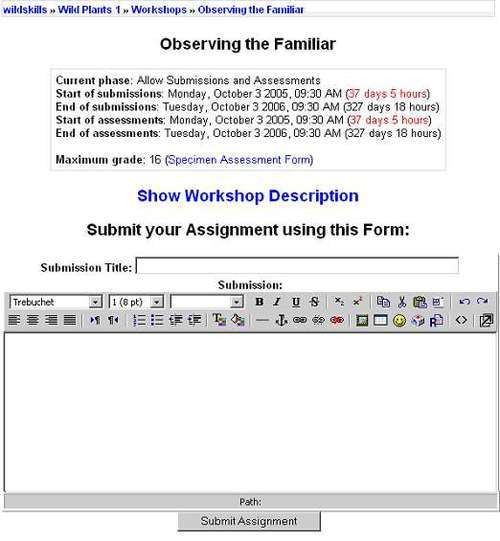
In this workshop, the student writes and updates some defined observations. These observations are then rated by other students in the course. When the student first enters the workshop, he or she sees directions for completing the workshop:
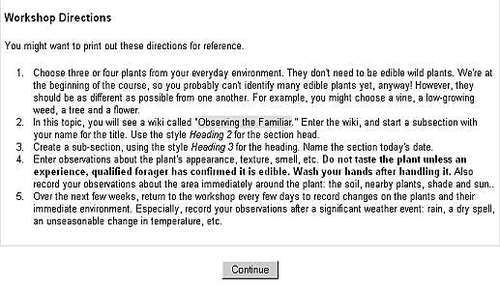
After reading these directions, the student continues to the workshop submission form (shown at the right).
Note the online word processor that the student uses to write the assignment. This gives the student basic WYSIWYG features. The same word processor appears when course creators create web pages, or when students write online Assignment entries, and at other times when a user is editing and formatting text.
At the top of the page, you can see that this workshop has opening and closing dates for submissions, and for assessments. It also has a maximum point value of 16. When the students assess each others' work, they will see the evaluation criteria and how many points each criterion is worth.
If you're able to read Step 5 in the workshop directions above, you can see that the student should return to this workshop every few days to update this assignment. To enable this, the course creator used a feature that allows students to resubmit workshops. The course creator could have chosen to allow a single submission, instead.
In the previous subsection, you saw how a student submits an assignment to a workshop. After each of the students submits an assignment, the student is given a chance to assess other students' work. In the following screenshot, Student Number2 has just submitted an assignment, and now can assess the work of Student 1. Student 2 would begin the assessment by clicking on the Assess link.
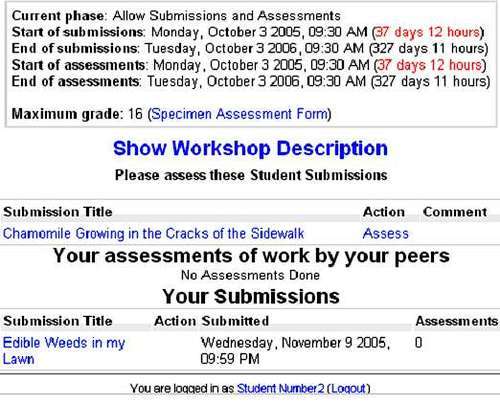
Under Your assessments of work by your peers, you can see that this user has not yet assessed anyone else's work. Under Your Submissions, you can see the title of this user's submission, and also note that no one has assessed the submission yet.
The Specimen Assessment Form at the top of the page displays the form that the student will use to assess others' work. However, it is a sample form. So it does not affect anyone's assessment.
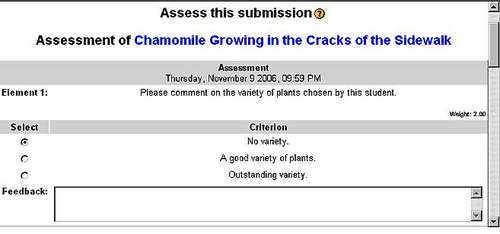
Clicking the Assess link brings up the assessment form for Student 1's workshop submission. The current user, Student 2, uses this form to assess the work. The teacher will have the opportunity to grade Student 2's assessment of Student 1's workshop. So not only does Moodle give you the ability to grade students' work, but also the ability to grade their assessments of other students' work. Because Moodle emphasizes collaborative effort, there are several places where a teacher can grade students on the quality of their collaboration.
Let us see what happens when you turn on the editing mode to make changes.
When a Guest user or a registered student browses your learning site, Moodle displays pages normally. However, when someone with course creator privilege logs in, Moodle offers a button for switching to the Editing mode:
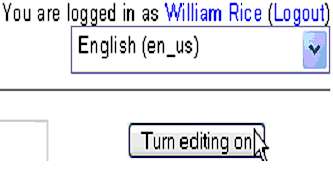
Clicking Turn editing on puts Moodle into the Editing mode:
|
Normal Mode  |
Editing Mode 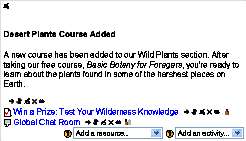 |
Let's walk through the icons that become available in editing mode.
Clicking the Edit icon  enables you to edit the content that precedes the icon. In this example, clicking the Edit icon that follows the paragraph enables you to edit the announcement:
enables you to edit the content that precedes the icon. In this example, clicking the Edit icon that follows the paragraph enables you to edit the announcement:
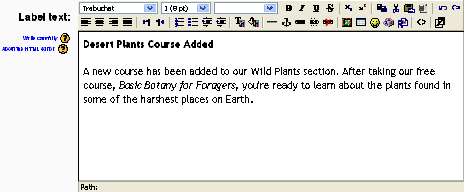
Clicking the Edit icon next to the quiz, Win a Prize, takes you to the editing window for that quiz. In that window, you can create, add, and remove quiz questions, change the grading scheme, and apply other settings to the quiz.
Clicking the Delete icon  deletes the item that precedes the icon. If you want to remove an item from a course, but you're not sure you'll want to use it later, then don't delete the item. Instead, hide it from view. Hiding and showing content is explained below.
deletes the item that precedes the icon. If you want to remove an item from a course, but you're not sure you'll want to use it later, then don't delete the item. Instead, hide it from view. Hiding and showing content is explained below.
I call these the Hidden/Shown icons  /
/ instead of Hide/Show because the icons indicate the current state of an item, and not what will happen when you click on them. The Hidden icon indicates that an item is hidden from the students. Clicking it shows the item to the students. The Shown icon indicates that an item is shown for the students. Clicking it hides the item from the students.
instead of Hide/Show because the icons indicate the current state of an item, and not what will happen when you click on them. The Hidden icon indicates that an item is hidden from the students. Clicking it shows the item to the students. The Shown icon indicates that an item is shown for the students. Clicking it hides the item from the students.
If you want to remove an item from a course while keeping it for later use, or if you want to keep an item hidden from students while you're working on it, hide it instead of deleting it.
Course material that a student observes or reads, such as web or text pages, hyperlinks, and multimedia files, are called resources. Course material that a student interacts with, or materials that enable interaction among students and teachers are called activities. Now let us see how to add some resources and activities to your Moodle site.
In the Editing Mode, you can add resources and activities to a course. Moodle offers more activities than resources, such as Chat, Forum, Journal, Quiz, Wiki, and more.
You add resources and activities using the drop-down menus that appear in the Editing Mode:
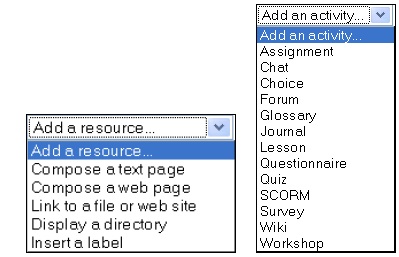
Selecting an item brings you to the Editing window for that type of item. For example, selecting Link to a file or website displays the window to the right. Note that you can do much more than just specify a hyperlink. You can give this link a user friendly name, and a summary description. You can also open it in a new window, and do much more.
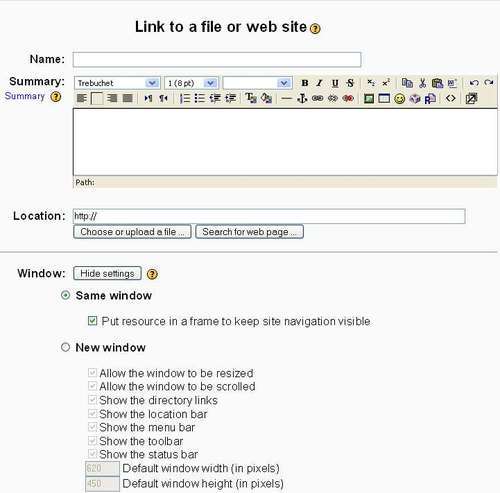
Almost every resource and activity that you add to Moodle has a Summary. This Summary appears when a student selects the item. Also, if the item appears in a list (for example, a list of all the resources in a course), the Summary is displayed.
While building courses, you will spend most of your time in the Editing window for the items that you add. You will find their behavior and appearance to be very consistent. The presence of a Summary is one example of that consistency. Another example is the presence of the Help icon  next to the title of the window. Clicking this icon displays an explanation of this type of item.
next to the title of the window. Clicking this icon displays an explanation of this type of item.
All the contents of the Administration block are displayed only when someone with administration, or course creator privileges has logged in. Students see a much more limited view of this block. The following screenshot shows the student's view of the Administration block on the left, and the teacher's on the right:
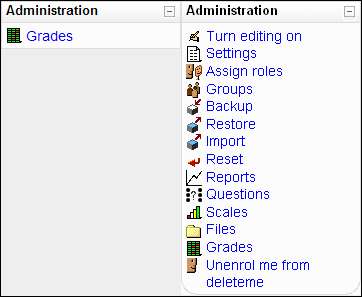
The choices on this block change depending on whether you are viewing the Front Page or a course, and the privileges that you have.
Choices in this block affect only the current course. For example, selecting Logs from the Front Page displays a page where you can view logs for all site activity, while selecting it from the course displays logs just for that course.
This short tour introduced you to the basics of the Moodle experience. The following chapters take you through installation of Moodle and creation of courses. If you work through those chapters in order, you will discover that many features are not mentioned in this tour. And, as Moodle is open source, new features can be added at any time. Perhaps, you will be the one to contribute a new feature to the Moodle community.






